The Shu Road and the Silk Road:Re-verifying the Diffusion Route of Indian Buddhism in Central China
Zhang Lihua
Sichuan Museum
Hou Shixin
Sichuan Museum
Li Lin*
Sichuan Museum
Abstract: The Shu Road is an important part of the Silk Road. As the transfer station for connecting the Maritime Silk Road with the Overland Silk Road and the starting point of the Southwestern Silk Road, Shu Yuandu Dao Route(Sichuan-India Road)—the predecessor of the Southwestern Silk Road,was the cultural exchange passage for China and its overseas neighbors before the opening of the famous Overland Silk Road. According to many archaeological findings and materials, Buddhism was introduced into the Central Plains along the Silk Road during the first century BC. Meanwhile,it was introduced into Bashu (the Sichuan Basin and its surrounding areas)along the Southwest Silk Road during the Eastern Han Dynasty (25-220)and was integrated into local cultures, which lead to the creation of the brilliant Buddhist culture and arts.
Keywords: the Silk Road, Shu Road, Buddhism, diffusion routes
Located at the upper reaches of the Yangtze River, Bashu (the Sichuan Basin and its surrounding areas) has a long history and rich cultural heritage. In the course of its long history, the criss-crossing ancient Shu Road enabled extensive and profound cultural exchanges with extraterritorial civilizations as early as the pre-Qin period (c.2100-221 BC). As an important part of the Silk Road, the Shu Road had close ties and exchanges with the Central Plains, Central Asia, and Southeast Asia along the Silk Road from early on and became an important channel connecting the Southwest Silk Road, the Overland Silk Road, the Maritime Silk Road, the Highland Silk Road, and the ancient Tea Horse Road at different times.
The Shu Road and the Silk Road
In recent years, archaeological discoveries of ancient Shu-related sites in the pre-Qin period have shown that Bashu had close trade ties and cultural contacts with India, which can date back to the pre-Qin period or even earlier. For example, during the Spring and Autumn Period and the Warring States Period (770-221 BC), the people living in southwest China opened a folk “smuggling route” through the mountains to the South Asian subcontinent and the China-Indochina Peninsula,an important trade route from the Chengdu Plain via Yunnan to Myanmar, India, Southeast Asia,Central Asia, West Asia, and the Mediterranean coast. These horse caravans, laden with Shu cloth,silk, and lacquerware, traversed the Gaoligong Mountains from Shu and arrived in Tengyue to exchange goods with Indian traders. At the same time, Indian and Central Asian glass, precious stones, seashells, as well as its religion and philosophy were also brought back by the returning horse caravans to the south-western barbarian region, which had always been considered a barbaric land by the people living in the Central Plain. This means that before the famous Northern Silk Road and the Maritime Silk Road were opened, the ancient Silk Road from the southwest to India, the “Sichuan-India Road,” became the gateway between China and the outside world, and this road became known as the Southwest Silk Road or the Southern Silk Road.
According to theBook of Han—Southwest Barbarians, When Zhang Qian, the Marquis of Bo Wang, went to Daxia (Tokhgra, now Afghanistan) in the first year of Yuan Shou (122 BC), saw Shu cloth and Qiong bamboo sticks, he asked the fishermen where these items came from. The fishermen answered, “from India, a few thousand miles away.” The fishermen had gotten merchants from Shu to buy them.The Records of the Grand Historianalso record that “Qian said, ‘When I was at Daxia, I saw Qiong’s bamboo staffs and Shu’s cloth.’ He asked: ‘How could this be?’ The people of Daxia said:‘Our merchants went to India and brought them back.’ ” The merchants of Daxia obtained the Shu cloth and the Qiong bamboo sticks because they “got them from the Shu merchants in the market,”and these “Shu goods” were “marketed by the Shu merchants in India.” These sources clearly show that the Shu-India Road trade was a long-distance trade carried out by the Shu merchants directly from Shu to India, with the route taking them from Sichuan to Yongchang in Yunnan and then along the Nandi River to Bhamo and Myitkyina in Myanmar, and then to Assam, Mathura, and Gandhara in India. This proves that before the opening of the Western Regions by the Han emperor Wudi (r. 141-87 BC) in the 2nd century BC, the route of Chinese silk transmission to the West would have been along the “Shu-India Road,” which went westwards. In 1936, Afghan archaeologists discovered large quantities of Chinese silk during excavations at Alexandria, a city that is thought to have been built in the second half of the fourth century BC; at that time, the “Silk Road” did not open in the north. Therefore it is possible that the silk was transported from Chengdu to the Indo-Pakistani Subcontinent via Yunnan and Myanmar, and thence to Central Asia (Wang, 1986). It is not a coincidence that the silk was in Kabul, a major route along the Silk Road in the south. After a comprehensive analysis of the Indian seashells excavated in southwest China, Duan Yu noted that“what connects the locations of these excavated seashells is the ancient transportation route between southwest China and the Indian region, that is, the Shu-India Road” (Duan, 2009).
During the Northern and Southern Dynasties (420-589), due to the occupation of the Hexi Corridor under different regimes, the South and the West mainly interacted with the Silk Road through Henan Road, from Chengdu to the eastern edge of the Qaidam Basin via Xining, Duoba, Riyue Mountain in Qinghai, then turns from Tianjun, Xili Gou and Dulan Temple to Ruoqiang County in Xinjiang to reach the West. This south Silk Road, which paralleled the Hexi Corridor, the main artery on the ancient Silk Road was an important route connecting China and the West in the 5th-6th centuries AD. It was also the main route for cultural exchanges at that time. This road was later called the “Henan Road,” “Qinghai Road” or “Tuyuhun Road.” Therefore, it is evident that the Shu Road has had a deep historical relationship with the Silk Road since the pre-Qin Dynasty. In this sense, it made a positive and irreplaceable contribution to the enlightenment, development, and free-flowing traffic of the Silk Road.
The Art of Gandhara in Early Buddhist Statues in the Bashu Region
The art of the Gandhara as an expression of Buddhist iconography arose in the Gandhara region of northwest India,and its emergence ended the period when there was no statue of Buddha in Indian Buddhism. During the Ashoka period in the 3rd century BC, Indian Buddhism spread outwards along the Silk Road. Numerous archaeological sources showed that during the Eastern Han period, India Buddhist culture intermingled with Chinese Taoist thought, and was accompanied by Taoist ideas of ascension to immortality such as Xi Wangmu, which appeared in ancient tombs in Bashu.Besides, there appeared a stone carving of a high-relief Buddha statue in the Eastern Han cliff tomb of Mahao in Leshan,Sichuan province (Figure. 1). This stone statue is 37 cm in height, with a rounded top light behind the head.

Figure 1
Dressed in a garment with a shoulder, the Buddha has a seal of fearlessness in his right hand, and his left hand is holding the end of the garment, seemingly seated cross-legged (Tang, 1989).Although the ancient Shu stone carvers carved the seated Buddha on the frieze, elements of the Gandhara carving style can be noticed. Another pottery statue of a seated Buddha (Figure. 2),unearthed in a cliff tomb of the Eastern Han dynasty in Pengshan county, Sichuan province, appears to be on the base of a money tree. The pottery base resembles a mountain tree base, hollow at the top, with a Buddha seated cross-legged in the center of the tree base. It has a high bun and a horizontal oval-shaped neckline,wearing a round-necked and a shoulder-length robe. And his right hand is holding the seal of fearlessness.
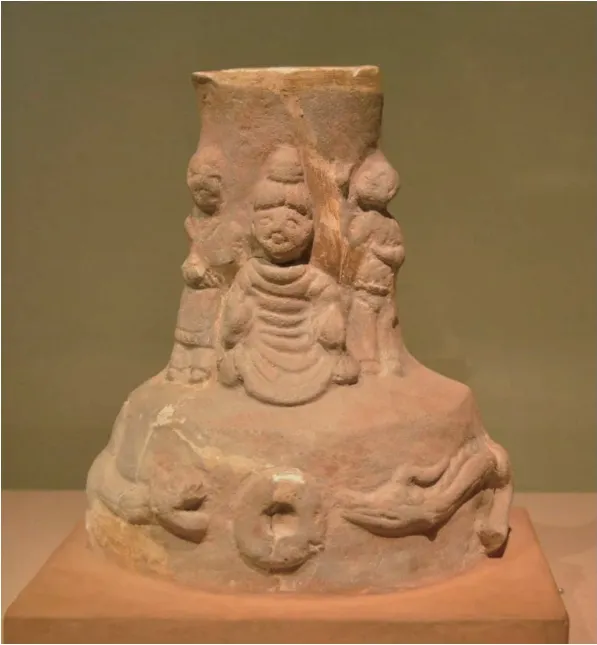
Figure 2
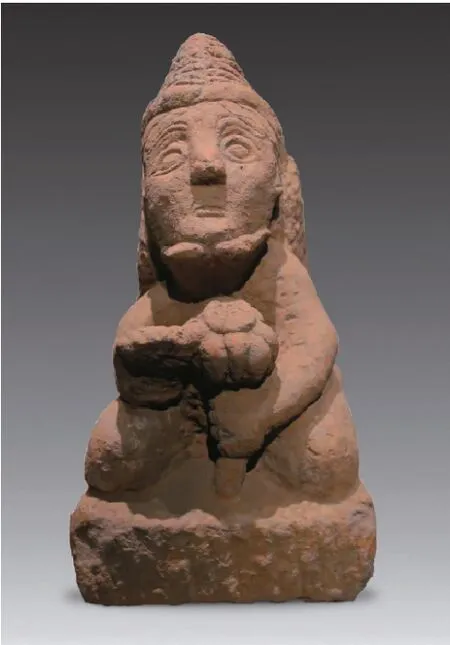
Figure 3
Dragonis a symbol of Chinese culture, which further demonstrates that Buddhism was integrated into Chinese Han culture since it entered into Bashu. It is common to find Buddha statues on money trees that were unearthed in the tombs of the Eastern Han Dynasty in Bashu,decorated with a bronze trunk on the money tree. These statues, with a horizontal oval-shaped light behind the head, slightly closed eyes, large ears, and a mustache in their upper lip, wear a shoulder-length robe. The Buddha sits cross-legged, and his right hand is upright with the palm facing outward. All fingers are pointing up towards the heavens; while his left hand holds the hem of the garment in a fist, the corners of which hang down in a U-shape around the right wrist and then down to the front of the foot (He, 1991). The stone statue of a human holding a lotus flower(Figure. 3) excavated in Sichuan, shows the characteristics of the late Eastern Han dynasty bronze statue of Gandhara Buddha. The truth that he is holding a lotus flower demonstrates that Buddhist thought was already introduced in the Eastern Han period. In addition, a brick from the Eastern Han period, collected by the Sichuan Museum in ZaojiaoTownship,Shifang County, Sichuan province (Figure. 4), has a pagoda carved in its center. It can be divided into three parts: the base, the body,and the loft. It has a four-story body, at the top of which the loft is on a three-tiered phase wheel. On each side of the pagoda, there is a bodhi tree, and on each side of the tree, there are pavilions which are believed to be Buddhist temples (Xie, 1987). Mouzi’s “Lihuolun”says, “(Emperor Ming of the Han Dynasty) built a Buddhist temple outside the western Yongmen Gate in Luoyang, with a mural of a thousand horses and horsemen, circling the pagoda three times.” In relation to the pagoda, theBook of the Later Han—Biographies of Liu Yu, Gongsun Zan, Tao Qianrecords that “in the late Eastern Han Dynasty, Ze Rong broke off three counties’ transportation, to build a large floating map temple, with gold plates placed on the top, buildings under below, and pavilions all around, which could accommodate about 3,000 people.” The pagoda, located in the center of the temple, with its body and loft extending from its base, derived an architectural style of the Gandhara pagoda. All of the above discussions indicate that the art of Buddhist statuary that emerged in the Eastern Han period in the Bashu area retains much of the style of Gandhara Buddhist art from the early years of the spread of Buddhism.
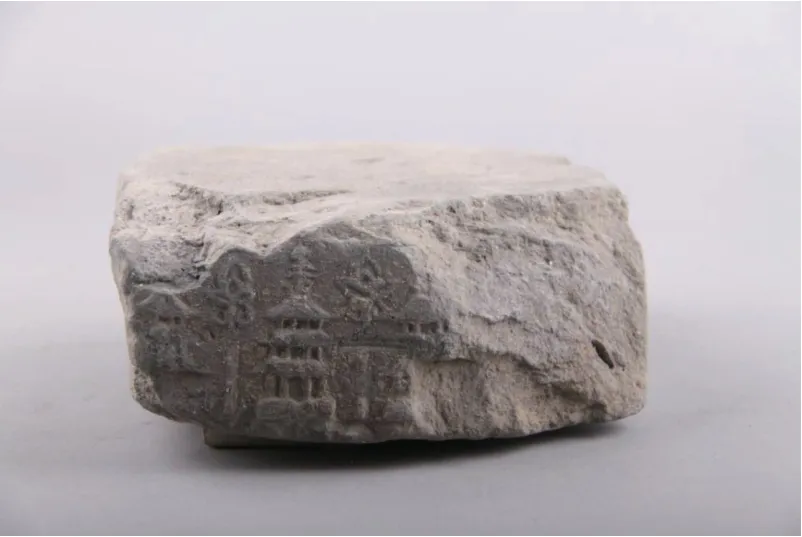
Figure 4
The Buddhist Statues of the Southern Dynasties in Bashu and Their Regional Characteristics
In recent years, with the in-depth study of the Southern Dynasties Buddhist statues in Sichuan Museum, Wanfo Temple collection, and the newly excavated Southern Dynasties Buddhist statues in Chengdu Commercial Street and Chengdu Xi’an Road cellars, it was determined that the Southern Dynasties Buddhist art in Sichuan was not only related to that of the Northern Dynasties but was also influenced by the Southern Dynasties’ capital city, Jiankang. Moreover, as a representative of Southern Dynasties Buddhist statue art in China, its regional characteristics are even more remarkable. Although Yoshimura believes that the Southern Dynasties statues excavated in Sichuan were faithful imitations of the style of Buddha statues popular in Jiankang at that time, the robe of the statue excavated at Qixia Mountain in Jiankang only has a bodice without a belt around the chest, a style that appeared in Mao County in the west of Chengdu at the end of the Qi Dynasty. The “double-collared, draped robe” that appeared in Mao County at the end of the Qi period, like the monument to the Buddha of Immeasurable Life in the first year of the Yongming reign of the Southern Qi Dynasty (479-502) in the Sichuan Museum (Figures 5 and 6), is the earliest Hanstyle Buddhist costume in China (Lei, 2013). It is a result of adapting Buddhism to the Chinese context in Sichuan and is of great importance to the study of Buddhism art from the Northern and Southern Dynasties.

Figure 5

Figure 6
The statue of Vai?rava?a Heavenly King is originally one of the four guardians. He was the northern guardian of the heavenly kings in Buddhism, and he had a special status and role in Bashu. Legend has it that he was born in the area of modern-day Yutian in Xinjiang and that he appeared to protect the Tang army when they fought against the western kingdom of Bashu and other regions and has since been eligible for special worship. During the Xiantong period of the Tang Dynasty (860-874), the army of the Nanzhao Kingdom invaded Chengdu, and the King appeared again at the North Gate Tower. From then on, a temple was built in Chengdu, and statues of the King of Heaven were frequently built along the roads leading from Chengdu to Nanzhao. Among the cliff statues at Jiajiang Qianfo Cliff, Qionglai Huazhi Temple, and Neijiang Xianglong Mountain, the statues of the King of Heaven stand out on both sides of the road with their left hand holding a pagoda and their right hand holding a sword, dressed in battle robes and armors.
Ashoka was the third king of the Peacock Dynasty in the ancient Indian state of Magadha, and one of the most devout Buddhists. During his reign, he extensively repaired temples, convened monks to compile and perfect many Buddhist scriptures. Besides, he also actively promoted the Dharma, protected life, and maintained Buddhism. He was respected as a famous protector of the Dharma. After Ashoka’s death, Buddhists made statues of his image and worshipped him. During the Northern and Southern dynasties, there were many statues of Ashoka erected in the Chengdu Plain (Figure. 7). Not only did the statue have Ashoka’s inscription on the back, but it also had the typical knee-length skirt. These historical figures occupy an important position in the history of Indian Buddhism, but they are extremely rare in Buddhist caves in the north. The vast majority of believers in the southwest not only worshipped Ashoka as a ritual statue, but also assigned him additional functions and expectations.With regard to the cross-footed Bodhisattva and the cross-footed Maitreya statue, the Maitreya was already recognized as the future Buddha in Hinayana Buddhism, and the Maitreya statue had already appeared early on. When Buddhism was introduced into China, with a considerable number of Maitreya statues in the art of Gandhara,the Maitreya statue was also introduced. By the period of the Sixteen Kingdoms (304-439) and the Northern and Southern Dynasties,various types of Buddhist statues appeared. With the cross-footed posture becoming a characteristic of the Maitreya Buddha, the crossfooted seated statue was also a characteristic of this period. The main figure is carved in high relief. He has a bun, a square face, and a smiling mouth, and is dressed in a “praising coat and sash.” The Maitreya always sits cross-legged on a square pedestal, with layers of folds of clothing dangling from the front of the pedestal, mostly with inscriptions. Taking the statue of Buddha in the first year (Figure.6) and the statue of Shi Fahai in the eighth year (Figure.7) of the Yongming era of the Southern Qi period for example, they are clearly recorded as Maitreya Buddha (this statue is inscribed as a cross-legged Maitreya) (Figures 8 and 9).
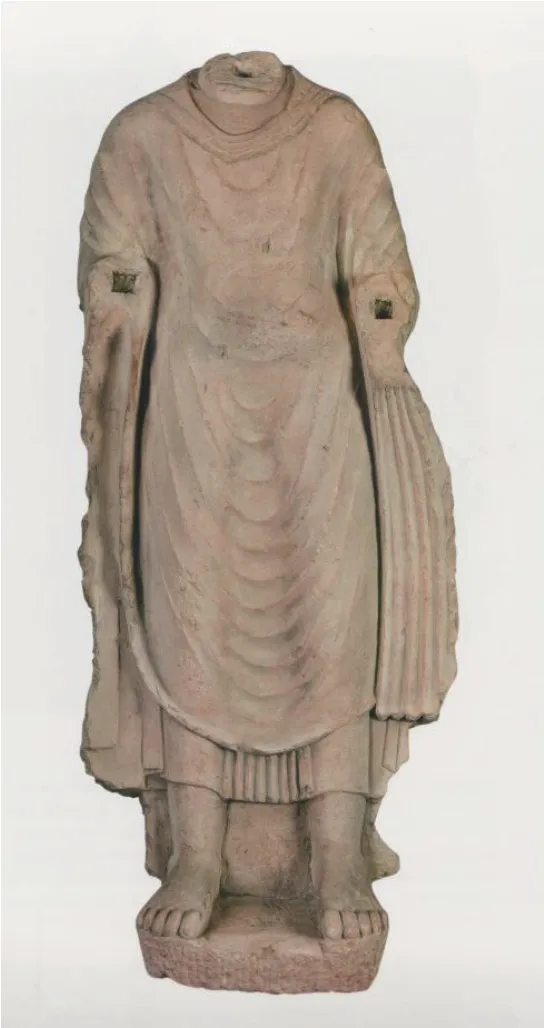
Figure 7
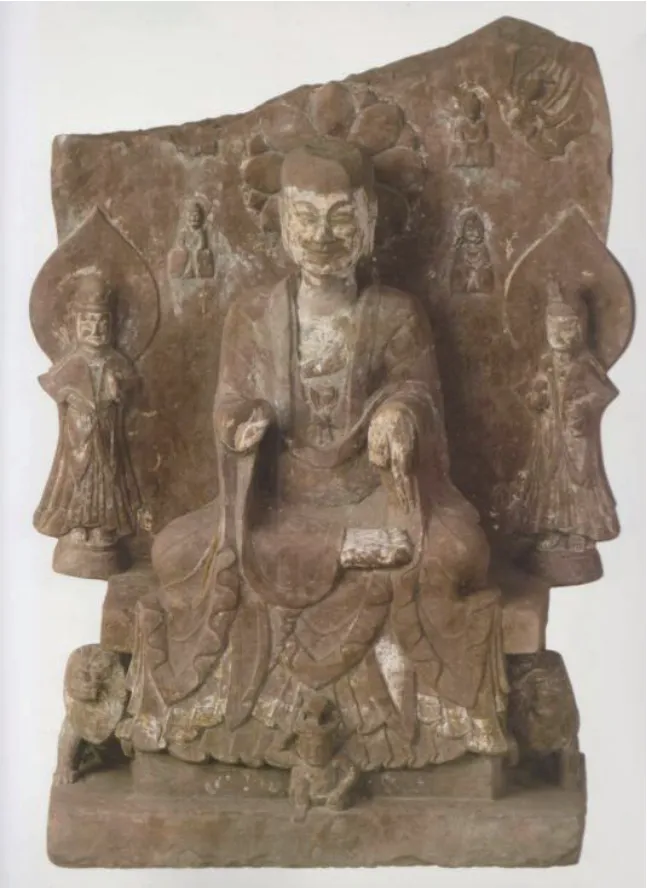
Figure 8
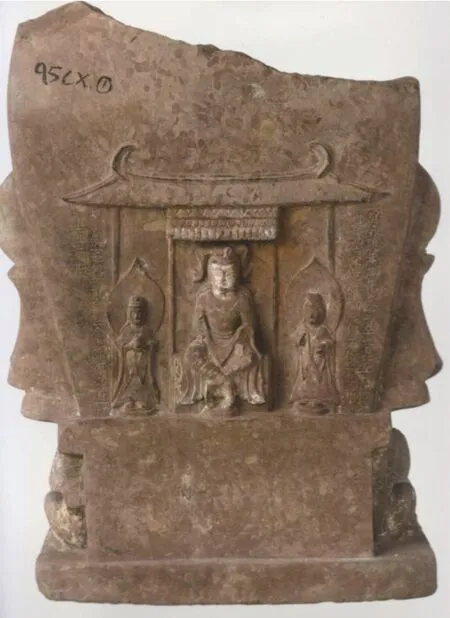
Figure 9
Particularly, the statue of two Buddhas, Sakyamuni Buddha and Prabhutaratna Buddha, seated side by side, which was created during the Southern Dynasties in Sichuan. Such statue was common during the Northern and Southern Dynasties and were iconic images of early Dharma art in China, but the two statues with Dharma content excavated at the Wanfo Temple in Chengdu have been proven to be relief carving of Wonderful Dharma Lotus Sutra. In the northern region prior to the Sui Dynasty, no scholarly recognition of the Dharma Sutra variation has been found, except for the image of the two Buddhas seated side by side. Thus, it is clear that the content of the Buddhist Dharma Sutra variation, which spread into Shu along the Southern Silk Road, predates the north one that was discovered at the Wanfo Temple in Chengdu. The relief carving of the Wonderful Dharma Lotus Sutra is also the earliest surviving image of the Wonderful Dharma Lotus Sutra that can be dated in China.
The Origin and Introduction of Buddhism in Bashu
Buddhism arose in ancient India during the 6th century BC and the image of the Buddha was created in the 3rd century BC in the region of Kendra in northwest India. It can be said that Gandhara art ushered in the era of Buddhist iconography.During the Ashoka period, Buddhism developed rapidly. The earliest areas to be affected were the areas around India, and there is no doubt that a large number of Buddhist remains show that the western region of Xinjiang was the first stop for the spread of Buddhism. This form of pictorial art, as an important part of the Silk Road, which was opened and used in the pre-Qin period,was bound to leave a rich cultural legacy in these regions whether it was imported into Bashu from the Western Corridor or from India via the Yunnan and Myanmar Roads, or via the Maritime Silk Road.
Throughout its development and evolution, it is easy to find that geographical differences and cultural traditions can produce differences in the absorption and understanding of Buddhist ideas.However, since the early Buddhism originated in India, people can just imitate it, so the early Buddha statues found in the north and south were similar and both of them were Gandhara Buddhist art. The process of creating this art was often influenced by local aesthetic concepts. Similarly, Buddhism itself, in the process of spreading, also needs to be integrated into the local areas as soon as possible for the local people to accept it. Therefore, Buddhism was in the process of continuous integration and innovation, which forms the regional characteristics of Buddhism. This is what we call “the process of adapting Buddhism to the Chinese context.”
In addition, the characteristics of the early Buddhist statues that emerged in Bashu and their characteristics and changes in the process of development are closely related to the geographical location of Chengdu and the ways of the spread of Buddhism in China. “The ‘Shu YuanDu DaoRoute,’ which ran alongYuanDu(India) into Shu, had already become an important part of the Silk Road during the pre-Qin period, and Shu cloth and Qiong bamboo sticks had already been used before 119 BC. In addition to the exchange of goods, Buddhism as a culture was brought into Bashu.Merchants were not the only people traveling these routes, Buddhist monks travelled with them as well.
The literature and archaeological findings show that the spread of Buddhism in China began at the end of the Han Dynasty (202-220), and that Buddhism was introduced to China and developed rapidly during the period of the Sixteen Kingdoms of the Eastern Jin Dynasty, and that it flourished during the Northern and Southern Dynasties. The archaeological findings of recent years show that the spread of Buddhism in the cities was initially dependent on the Taoist idea of ascension to immortality. This Taoist idea was spread through the funerary practices of the people, as evidenced by the presence of early Kendra statue art and pagoda and temple motifs in the tombs of the Eastern Han Dynasty in the city of Bashu. During the Northern and Southern Dynasties, Buddhism was promoted and flourished. The Southern Dynasties Buddhist statue art, represented by the Wanfo Temple, demonstrates the charm of the integration of Buddhist culture into the local art, whether it be the Southern Dynasties Buddha statue excavated in Chengdu’s commercial street or Sichuan’s Mao County. Buddhist culture has also been influenced by the Northern Dynasties. The style of the Southern Dynasties includes the conch hair on the Buddha’s head, the statue of Ashoka, and the original surplice bodice, as well as the Indian art of the Gandhara. This also confirms what Su Bai said, “the construction of temples and the temples of the Southern Dynasties were in full bloom at this time, and the worship of Buddha statues seems to have shown signs of attention to the Tianzhu form”(Su, 1999). The form and content of the statues from the Southern Dynasties in Sichuan reflect the fact that Buddhism was integrated into the social life of the local people immediately after it arrived from India, beginning the process of adapting Buddhism to the Chinese context.
Conclusion
Buddhism, as a religious culture, was initially spread among the common people along with the flow of trade along the Silk Road, which was well connected to the Shu Road. As far as the route of Buddhism is concerned, scholars and experts differ in their opinions. Some believe that Buddhism in Sichuan came from the Hexi Corridor, others believe that it came from the Ganqing Road, and still others believe that it came from the lower reaches of the Yangtze River upstream into Sichuan.Nevertheless, another group of scholars believes that Buddhism in Sichuan came from the southwest through Yunnan, which is entirely possible, especially since Ren Jiyu, in hisHistory of Buddhism in China, holds that Sichuan Buddhism predates the Eastern Jin Dynasty. Despite the lack of written records, archaeological findings are sufficient to prove that Buddhism had already spread in Sichuan before the Three Kingdoms, and that it was most likely imported through Yunnan. The presence of ceramic Buddha statues in the Eastern Han tombs of Zhaotong in Yunnan discovered in recent years,and the tombs of the Huo family in the Eastern Jin Dynasty, also in Yunnan, with lotus petals and decoration on the top of the tombs, further suggest that Buddhism was introduced into China along the Western Silk Road and the Southwestern Silk Road respectively in the Eastern Han period.
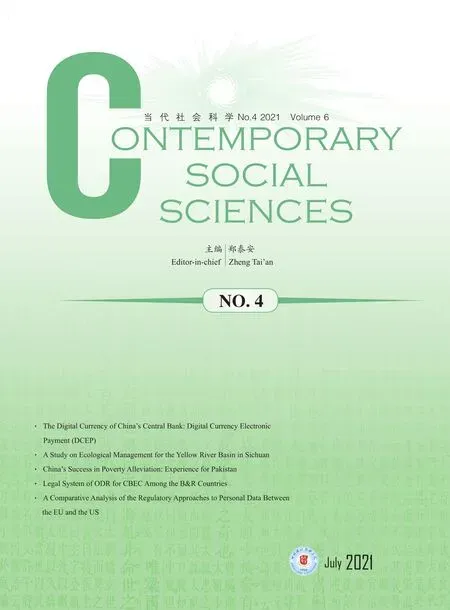 Contemporary Social Sciences2021年4期
Contemporary Social Sciences2021年4期
- Contemporary Social Sciences的其它文章
- On the Canonicity of the 1947 Edition of T‘a(chǎn)i-Chi Ch‘üan
- The Digital Currency of China’s Central Bank: Digital Currency Electronic Payment (DCEP)
- A Study on the Management of Career Development of Young Teachers in Higher Education Institutions from the Perspective of Career Anchors
- Zhang Sixun and the Prosperous Astronomy in the Song Dynasty
